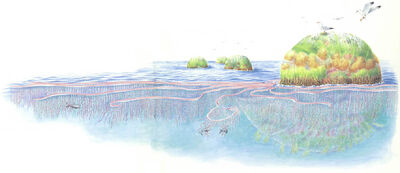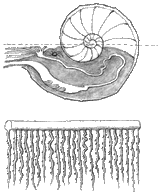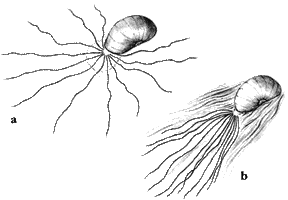No edit summary |
(Adding categories) |
||
| Line 8: | Line 8: | ||
<p style="text-align: justify;">[[File:Kraken_3.gif|thumb|288px|Kraken's locomotion.]]The air-filled chambers of the kraken's shell mean that it floats with the living animal and the tentacles just submerged (a). It moves by expelling waste water through its syphon, propelling the shell backwards and allowing the tentacles to trail behind (b).</p> |
<p style="text-align: justify;">[[File:Kraken_3.gif|thumb|288px|Kraken's locomotion.]]The air-filled chambers of the kraken's shell mean that it floats with the living animal and the tentacles just submerged (a). It moves by expelling waste water through its syphon, propelling the shell backwards and allowing the tentacles to trail behind (b).</p> |
||
| + | [[Category:The New Dinosaurs]] |
||
Revision as of 01:51, 5 July 2013

Kraken, Giganticeras fluitarus
The Kraken, Giganticeras fluitarus, is a massive floating ammonite with a shell 13 feet in diameter. Its tentacles are covered with poisonous barbs like those of a jellyfish. These deadly tentacles spread out in an area of 67 feet in diameter. The kraken only fears the pelorus, who is immune to its poisonous stings.
The ammonites of the Mesozoic seas were mostly swimming animals that moved freely about in the ocean waters chasing small swimming creatures that they caught with their tentacles. In Cretaceous times they developed into a number of different forms. There were those with heavy shells produced in irregular coils, that spent their time crawling along the sea bed. Others were freely drifting animals, filtering microscopic food particles from the water using very fine tentacles. This second trend has reached a pinnacle with the modern kraken.
The shell of the kraken is truly enormous, some specimens reaching 4 metres (13 ft) in diameter. The shell acts as a protective armour, as well as a float to keep the animal in the fertile surface waters. It has twelve tentacles that it spreads out around itself, and each of these has thousands of trailing fibres that are armed with stings and hooks. The whole arrangement forms a deadly net that covers an area of about 20 metres (67 ft) in diameter. The kraken will eat almost anything that becomes entangled in its traps, from microscopic floating plants, to fairly large fish. Many krakens often drift in the same area of productive waters, their floating shells acting as perches for migrant birds and pterosaurs.

Kraken's tentacles.
The internal structure of the kraken is a (scaled-up) version of the internal structure of any shelled cephalopod. The shell has a number of chambers, and the animal occupies the last one. As the kraken grows it produces more shell, moves forward and lays down a wall to create a new chamber behind. A blood vessel connecting all the chambers controls the air pressure and hence buoyancy.
The twelve tentacles with their trailing curtain of stings and hooks, radiate from the mouth at the shells entrance.

Kraken's locomotion.
The air-filled chambers of the kraken's shell mean that it floats with the living animal and the tentacles just submerged (a). It moves by expelling waste water through its syphon, propelling the shell backwards and allowing the tentacles to trail behind (b).
